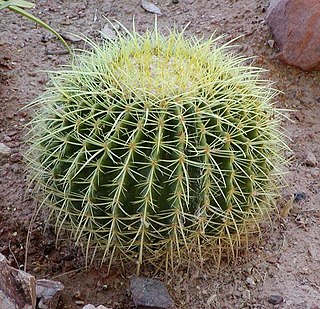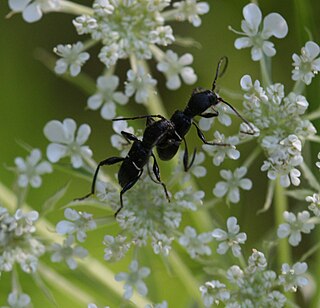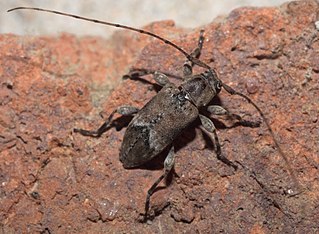
A cactus is a member of the plant family Cactaceae, a family comprising about 127 genera with some 1,750 known species of the order Caryophyllales. The word cactus derives, through Latin, from the Ancient Greek word κάκτος (káktos), a name originally used by Theophrastus for a spiny plant whose identity is now not certain. Cacti occur in a wide range of shapes and sizes. They are native to the Americas, ranging from Patagonia in the south to parts of western Canada in the north, with the exception of Rhipsalis baccifera, which is also found in Africa and Sri Lanka. Cacti are adapted to live in very dry environments, including the Atacama Desert, one of the driest places on Earth. Because of this, cacti show many adaptations to conserve water. For example, almost all cacti are succulents, meaning they have thickened, fleshy parts adapted to store water. Unlike many other succulents, the stem is the only part of most cacti where this vital process takes place. Most species of cacti have lost true leaves, retaining only spines, which are highly modified leaves. As well as defending against herbivores, spines help prevent water loss by reducing air flow close to the cactus and providing some shade. In the absence of true leaves, cacti's enlarged stems carry out photosynthesis.

The insects of the beetle family Chrysomelidae are commonly known as leaf beetles, and include over 37,000 species in more than 2,500 genera, making up one of the largest and most commonly encountered of all beetle families. Numerous subfamilies are recognized, but the precise taxonomy and systematics are likely to change with ongoing research.

The longhorn beetles (Cerambycidae), also known as long-horned or longicorns, are a large family of beetles, with over 35,000 species described.

Barrel cacti are various members of the two genera Echinocactus and Ferocactus, endemic to the deserts of Southwestern North America southward to north central Mexico. Some of the largest specimens are found in the Sonoran Desert.

LeConte's thrasher is a pale bird found in the southwestern United States and northwestern Mexico. It prefers to live in deserts with very little vegetation, where it blends in with the sandy soils. LeConte's thrashers are nonmigratory birds that reside in the same territory annually. Although the species has been decreasing in certain areas of its range, in particular California, it still is abundant enough to not be considered for vulnerable status.

Pleocoma is the only extant genus of rain beetles and is endemic to the Pacific states of North America. Fossil remains of Pleocoma have been found in the Yixian Formation in China, suggesting beetles in this genus have existed in something like their present form since at least the Cretaceous period. There are 27 described species in Pleocoma.

Ariocarpus fissuratus is a species of cactus found in small numbers in northern Mexico and Texas in the United States. Common names include living rock cactus, false peyote, chautle, dry whiskey and star cactus.

Moneilema gigas is a large, flightless, black beetle native to the Sonoran desert at elevations below 1500 metres. The front wings are fused forming a single, hardened shell. Collectively - with 19 other Moneilema species - M. gigas is also known as the cactus longhorn beetle.

Buprestis is a genus of beetles in the tribe Buprestini, the jewel beetles. As of 2011 there were 78 described species distributed across most of the world's biogeographic realms except parts of Africa and Antarctica.

Euderces is a genus of longhorn beetles, family Cerambycidae. They are found in South, Central, and North America, with the centre of diversity in southern Mexico and Guatemala.

Eleodes is a genus of darkling beetles, in the family Tenebrionidae. They are endemic to western North America ranging from southern Canada to central Mexico with many species found along the Mexico-United States border. Some species have been introduced to Colombia. The name pinacate is Mexican Spanish, derived from the Nahuatl (Aztec) name for the insect, pinacatl, which translates as "black beetle".

The cactus wren is a species of wren that is endemic to the deserts of the southwestern United States and northern and central Mexico. It is the state bird of Arizona, and the largest wren in the United States. Its plumage is brown, with black and white spots as markings. It has a distinctive white eyebrow that sweeps to the nape of the neck. The chest is white, whereas the underparts are cinnamon-buff colored. Both sexes appear similar. The tail, as well as flight feathers, are barred in black and white. Their song is a loud raspy chirrup; akin in the description of some ornithologists to the sound of a car engine that will not start. It is well-adapted to its native desert environment, and the birds can meet their water needs from their diet which consists chiefly of insects, but also of some plant matter. The cactus wren is a poor flier and generally forages for food on the ground. Ornithologists generally recognize seven subspecies, with the exact taxonomy under dispute.

Styloleptus is a genus of longhorn beetles of the subfamily Lamiinae. It was described by Dillon in 1956.

Moneilema armatum is a species of flat-faced longhorn in the family of beetles known as Cerambycidae. It is found in the southwestern United States and northern Mexico. The flightless beetles often feed on prickly pear cactus, boring into the stems and roots.
Moneilema semipunctatum is a species of beetle in the family Cerambycidae. It was described by John Lawrence LeConte in 1852. It is known commonly as the cactus borer beetle. Beetles of genus Moneilema are known commonly as cactus longhorn beetles. It is native to North America, where it occurs in the western United States and Mexico.

Dactylopius is a genus of insect in the superfamily Coccoidea, the scale insects. It is the only genus in the family Dactylopiidae. These insects are known commonly as cochineals, a name that also specifically refers to the best-known species, the cochineal. The cochineal is an insect of economic and historical importance as a main source of the red dye carmine. It has reportedly been used for this purpose in the Americas since the 10th century. Genus Dactylopius is also important because several species have been used as agents of biological pest control, and because several are known as invasive species.

Eupogonius is a genus of longhorn beetles of the subfamily Lamiinae. It was described in Journal of the Academy of Natural Sciences of Philadelphia by John Lawrence LeConte in 1852. The species are found across Eastern North America south to Argentina in forests and woodlots.
Gerstaeckeria is a genus of cactus weevils in the beetle family Curculionidae. There are more than 40 described species in Gerstaeckeria.

Chilocorus cacti, known generally as the cactus lady beetle or the twice-stabbed cactus lady beetle, is a species of lady beetle in the family Coccinellidae. It is native to the Caribbean region, North America, Central America, and South America. The adults and larvae feed on scale insects and attempts have been made to use it for biological pest control.
Drosophila metlerri, commonly known as the Sonoran Desert fly, is a fly in the genus Drosophila. The species is found in North America and is most concentrated along the southern coast of California and in Mexico. D. mettleri are dependent on plant hosts, namely, the saguaro and cardon cacti. Thus, they are most prevalent in arid, desert conditions. It is able to detoxify chemicals found in the rotting liquid of cacti hosts, which allows it to use otherwise lethal soil as a nesting site.

















